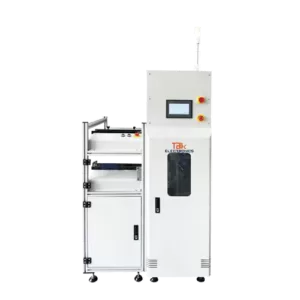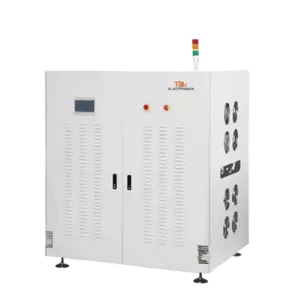Buffer Conveyor
ElectronicsTalk provides the magazine-type buffer conveyor, it has a total of up to 6 modes: FIFO, LIFO, By-pass, loading, unloading, and buffering.
In addition, the multi-functional vertical type buffer can be used more flexibly because of adding a 90-degree angle of the extended guide rail.
Then, the NG buffer can buffer the PCB board by its unique top and down design after the inspection machines; the OK board will just pass through, but the NG board will be delivered onto its upper rail to get stored and wait for manual confirmation.
Lastly, the large cooling buffer is customized to buffer the PCB board and drop its temperature after the soldering process
Buffer conveyor is basically used to buffer, store, and deliver PCB board. ElectronicsTalk classified and provide 4 types of buffer conveyors which are varied in their own functionality.
What is a buffer conveyor?
Buffer conveyors are a crucial part of many manufacturing and distribution processes. As their name suggests, they act as a “buffer” to temporarily hold materials between processes. Maintaining an efficient buffer conveyor system is key to achieving high throughput and avoiding bottlenecks.
The main purpose of a buffer conveyor is to decouple processes so that one process doesn’t have to wait on another to finish. For example, a buffer conveyor placed between an assembly line and a packaging station allows the assembly line to continuously run even if packaging falls behind. The conveyor holds the finished goods temporarily until they can be packaged.
Why Buffer Conveyor Efficiency is Important
Improving buffer conveyor efficiency can significantly increase productivity and reduce costs in a facility. Here are some of the major benefits:
- Reduces Bottlenecks – An efficient buffer conveyor absorbs fluctuations in process times and prevents bottlenecks. This allows upstream processes to operate at maximum capacity.
- Increases Throughput – By preventing delays, proper buffering enables processes to achieve higher throughput. More finished products can be manufactured in the same amount of time.
- Saves Energy – Inefficient buffering often requires processes to frequently start and stop. This wastes energy. Effective buffering allows processes to run continuously at peak efficiency.
- Reduces Labor Costs – Stopping and starting processes requires additional labor to manage. Proper buffering enables more automation and smoother operations.
- Improves Quality – Constant operation with fewer stops and starts results in less wear on equipment and more consistent quality.
How to Improve Buffer Conveyor Efficiency
Here are some key strategies for optimizing buffer conveyor operations:
Identify and Address Bottlenecks
Analyze the manufacturing process to detect where bottlenecks are occurring. Prioritize improvements to buffer conveyors feeding these constrained processes first. Even small gains can significantly increase throughput.
Optimize Buffer Conveyor Speed
The speed of the buffer conveyor determines its holding capacity. Set the speed to match the difference in process rates between upstream and downstream operations. Too fast and capacity is wasted. Too slow and starvation occurs.
Use the Right Buffer Conveyor Type
Consider characteristics like the required buffer capacity, product weight, and transfer points when selecting a buffer conveyor. Common choices are belt, roller, chain, and skate wheel conveyors.
Implement a Buffer Management System
Advanced computerized buffer management systems can monitor inventory levels and automatically control conveyor speed. This provides precise buffering control with little human intervention.
Efficient buffering is a critical component of lean manufacturing. By implementing these buffer conveyor best practices, facilities can achieve substantial gains in productivity, quality, and profitability. A well-designed buffering system helps create a smooth, consistent workflow and reduces waste.
Pinpointing and Fixing Bottlenecks to Optimize Buffer Conveyors
Bottlenecks are a major source of inefficiency in buffer conveyor lines. Finding and eliminating these bottlenecks is critical for improving productivity.
To identify bottlenecks, analyze the conveyor line during operation. Look for points where material flow slows down or piles up. Timing each segment and monitoring cycle times can also pinpoint uneven workloads.
Once bottlenecks are found, there are several ways to optimize them:
- Reconfigure the line layout to better balance workloads
- Upgrade equipment speed at constrained stations
- Match conveyor pace to downstream capacity
- Add more buffering capacity before bottlenecks
- Implement automated controls to prevent overload
Continually monitoring the line and addressing bottlenecks as they arise is key. Even small bottlenecks can quickly cascade into major delays if left unresolved. Proactive bottleneck management helps ensure smooth, efficient buffer conveyor operation.
Optimizing Buffer Conveyor Speed for Maximum Efficiency
Properly setting buffer conveyor speed is crucial for efficiency. If the conveyor is too slow, the material will pile up and overwhelm downstream processes. If it’s too fast, energy is wasted.
To optimize speed:
- Identify the speed capacity of downstream equipment the conveyor feeds into. This is the maximum rate that station can handle.
- Set the buffer conveyor speed to match the flow rate of the downstream equipment. This prevents bottlenecks while avoiding unnecessary speed.
- Continually monitor and adjust speed as needed. As conditions change, conveyor speed may need tuning to prevent backups.
- Consider implementing variable frequency drive controls. These automatically adjust conveyor speed based on real-time flow, preventing overfeeding.
Correct buffer conveyor speed reduces jams, minimizes energy use, improves equipment life, and increases overall system throughput. Work with experienced suppliers to properly size and integrate your conveyor for optimum speed and efficiency.
Selecting the Optimal Buffer Conveyor Type for Your Application
Choosing the right type of buffer conveyor is crucial for maximizing efficiency. There are various options available, each with its own pros and cons. The ideal choice depends on factors like:
- Weight of Materials – Heavy materials require more durable conveyor models that can handle the load without frequent maintenance. Lightweight materials can use standard lower-cost models.
- Speed Needs – Some applications need high-speed buffering, which requires conveyors designed for rapid throughput. Slower lines can use basic affordable models.
- Vertical Lifts – Applications with lots of elevation changes need inclined or vertical conveyors. Horizontal transport only needs standard flat conveyors.
- Environment – Extreme environments like cold storage or washdown need specialized conveyors rated for those conditions.
- Budget – More heavy-duty or feature-rich conveyor systems have a higher upfront cost but can save long-term through reliability and efficiency.
Working with a knowledgeable conveyor supplier is recommended when selecting a buffer conveyor. They can assess your specific application and recommend the right type, size, features, and capacity to optimize workflow and safety. The optimal buffer conveyor enhances quality, minimizes downtime, and reduces costs.
Types Of Buffer Conveyor
Leveraging Buffer Management Systems for Conveyor Optimization
Implementing an automated buffer management system provides intelligent control of conveyor operations. These systems offer several key benefits:
- Real-time visibility – Sensors track material flow rates, buffer levels, and equipment speeds. This data enables informed adjustments.
- Predictive analytics – Software analyzes trends to forecast potential bottlenecks before they happen.
- Automated speed control – Conveyor speed can be automatically adjusted based on flow, preventing overload conditions.
- Reduced labor – Less manual oversight is needed with automated supervision.
- Increased throughput – Bottlenecks are minimized, allowing optimized production flow.
- Energy savings – Conveyors run at the minimum required speeds, reducing waste.
With a buffer management system, conveyor lines can operate at peak efficiency with minimal manual intervention. The system acts as an intelligent optimizer, preventing problems and ensuring optimal flow. This drives significant gains in productivity and quality.
Summary of the key points Of Buffer Conveyor
- Identifying bottlenecks by observing conveyor lines, timing segments, and monitoring inventory buildups is the first step to improving efficiency.
- Addressing bottlenecks can involve adjusting layouts, upgrading equipment, matching conveyor speeds, adding buffer capacity, and implementing automated controls.
- Optimizing buffer conveyor speed requires matching the pace to downstream equipment capacity to prevent pileups or energy waste.
- Using buffer management systems provides real-time tracking, predictive analytics, and automated speed control for maximum throughput.
- Continually monitoring conveyor systems and quickly addressing emerging bottlenecks is crucial for sustaining peak performance.
- Selecting the optimal buffer conveyor type based on factors like weight capacity, speed, environment, and budget ensures smooth, reliable operation.
- Properly designed and controlled buffer conveyors are a vital component of lean, efficient manufacturing.





